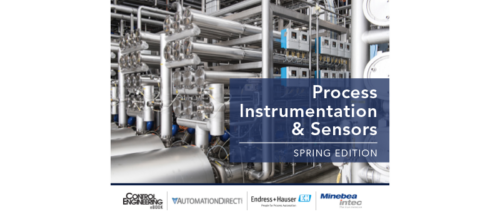Micro Motion announces flowmeter performance strides
Boulder, CO— Better flowmeter measurement performance and safety certification were among Coriolis line developments announced by the Micro Motion division of Emerson Process Management at the 2006 Perspectives event held recently at Micro Motion headquarters. Company executives, including John Berra, president of Emerson Process Management, and Thomas Moser, president of Micro Motion, were on hand to outline the improvements.
Among the specifics: all Micro Motion flowmeters are now rated to operate at temperatures to 800 °F (427 °C). The meters are equipped with heat-tolerant components throughout the sensor body, and their transmitters can be located away from the sensor at the end of an Emerson-supplied flexible conduit/cable. Here are additional details about the improvements.
Among the announcements and developments made at Micro Motion’s recent 2006 Perspectives event was the delivery of the company’s 500,000th Coriolis flowmeter, destined for an application at Anheuser-Busch.
Performance
F-Series line of compact Coriolis meters reportedly now offeritter for use in safety integrity level (SIL-2 and SIL-3) applications. This certification ensures a higher level of safety, which reportedly translates to better meter availability in critical processes.
Responding to customer concerns about flowmeter safety—in particular, requests to inspect flowmeter welds prior to shipment—Micro Motion can now do so in-house with its own industrial X-ray equipment at its Boulder and Chihuahua, Mexico, manufacturing facilities. In addition, at least 5% of all Micro Motion flowmeters receive random X-ray weld inspections.
Micro Motion president Thomas Moser noted that customers typically need to verify a flowmeter’s performance after it has been operational for a while. All types of flowmeters tend to have difficulty detecting a very small but non-zero rate of flow through the device. Conversely, sensor drift causes some units to start to report a small flow rate when there is none. In such cases, operators must periodically determine when the flow rate is zero and manually tweak the meter’s output to match. Improved MVD technology reportedly boosts long-term stability of Coriolis flowmeters to a level that eliminates the need for such periodic field zeroing.
In-situ verification
Micro Motion also noted that its Elite Coriolis flowmeter now can provide an in-situ health assessment. Specifically, it can determine if it has lost any stiffness due to corrosion or scouring. When commanded by an operator, the meter can apply a multi-frequency drive signal to the tube using the same mechanism it uses to induce a twist in the meter’s U-tube by means of the Coriolis effect.
The degree of twist is normally measured to compute the flow rate through the tube. The verification test measures the stiffness of the flow tube to determine if the U-tube is any less stiff than it was in the factory. This test relies on a probing signal or “tone” with multiple frequencies such that the fluid inside the U-tube has no effect on the measurement, regardless of fluid density or how fast the fluid is flowing.
Arguably the most significant advantage of this self-verification test is the ability to detect potential problems without removing the meter from the line or shutting down the process. It can’t detect every condition that might affect the meter’s health (a soft coating clogging the tube is still detectable only by disassembling the meter), but it can give advanced warning of impending failures due to slow deterioration of the tube. Maintenance technicians should not need to swap out mission-critical meters on a regular basis just to check for deterioration. They can wait until the validation test indicates that a problem is developing.
Entrained gas
End-users attending the 2006 Perspectives event may have paid most attention to the improved performance of the Elite flowmeter when measuring two-phase fluids. Two-phase fluids contain a mixture of liquid and gas—typically air accidentally entrained in a product or intentionally mixed-in to give the product more “body.”
Traditional Coriolis technology has had trouble dealing with the effects of the air bubbles, which cause the density of a two-phase fluid to fluctuate, throwing off the balance of the U-tube and altering the dampening caused by the flow stream itself. Larger bubbles cause more distortion.
Micro Motion’s Moser described how the Elite flowmeter has been better isolated from the effects of bubbles, mechanically and electronically. The software driving the Coriolis measurement process can now detect and continue to operate in the presence of two-phase flow without air eliminators or flow conditioning devices. Faster processing speeds also help.
Bruce Johnson, engineering manager for Texas facilities says the Lubrizol Corp. is already using the new Micro Motion Coriolis two-phase flow software with success. With earlier legacy Coriolis flowmeters, the mass flow rate of feedstocks mixed with entrained air could not be accurately measured. The resulting measurement errors lead to costly excesses and deficiencies in raw material consumption. He reports that Micro Motion’s ability to measure two-phase flow will lead to more accurate measurements to produce Lubrizol products.
In other developments at the event, Micro Motion announced the shipment of its 500,000 th Coriolis flowmeter and the opening of a new European flow service center for measurement products from Micro Motion and sister divisions Rosemount and Brooks Instrument. Located between Arnhem and Utrecht, Netherlands, the new facility will house flow device manufacturing, calibration and training facilities, and more than 200 multi-lingual sales and support staff.
In addition, Micro Motion’s Model 3711 gas flow computer is reportedly the first gas flow computer to use and benefit from the accuracy of Coriolis direct mass flow measurement. The system delivers gas measurement data in compliance with API MPMS Chapter 21.1, and in accordance with AGA8-92 world standards.
— Vance VanDoren , Ph.D., P.E., Control Engineering consulting editor
Do you have experience and expertise with the topics mentioned in this content? You should consider contributing to our CFE Media editorial team and getting the recognition you and your company deserve. Click here to start this process.


